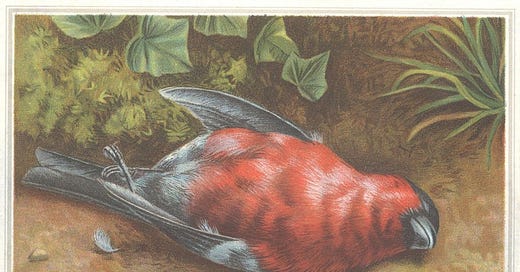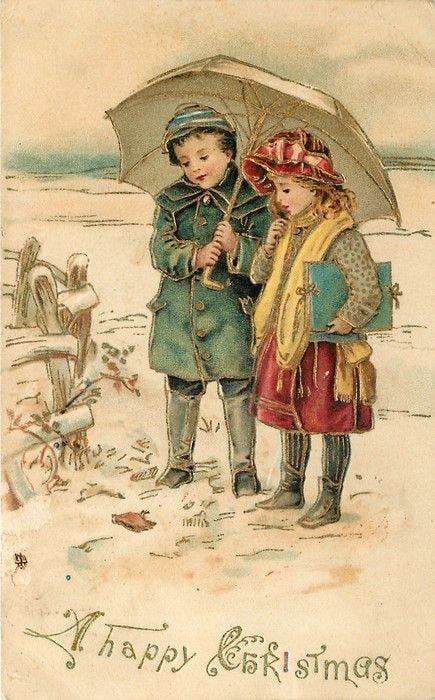As we’re in day 5 of both Christmastide and Hanukkah (having just lit several menorahs at a rabbi friend’s house this weekend), I thought I could take a moment to talk about dead bird Christmas cards. It’s certainly a weird tradition that has, obviously, fallen out of favor. Yet at one point folks sent these to one another regularly.
They came to my attention again because of Weird Christmas, to whom I sold a story which (I hope) I can share before what the majority of you celebrate as New Year’s Eve. Weird Christmas shared these classic images:
I could go on, but you get the gist. What stuck out to me is how many of these Weird Christmas shared without knowing the origin.
Yes, it’s true that 19th century cards in general were rather morbid and horrifying. And they certainly practiced memento mori at this time of year, whether from the holly wreaths or bonfires burning figures in effigy or placing a skull in the back of a snow covered winter wonderland.
But that wasn’t why.
Particularly when you consider how many robins and wrens are dead in these pictures.
The Feast of St. Stephen is intimately bound up in Twelvetide — Advent being simultaneously the retroactive anticipation of the birth of Jesus and the forward anticipation of the second coming of Christ, who stood at the death of the first martyr, Stephen. The Armenians celebrate St. Stephen’s day on the 25th, the West on the 26th, the Gregorians on the 27th, the Julians on the 9th. It seems diplomatic of me, therefore, to write about this on the 29th.
There was a coinciding of this holiday with Boxing Day — the day to give alms to the poor and less fortunate — with the Irish Wren Day — the day to kill a robin or wren and put it on top of a holly staff. I’m going to link below to a bountiful history of the tradition. The cards, then, seem to imply we remember the plight of the poor. It’s particularly poignant when Boxing Day has been converted entirely into further selfishness of consumption for us and our families, essentially spoiling us further rather than contributing to relieving the difficulties and increasing the opportunities of those less fortunate than us. I like the idea of moving us back towards generosity, alms, and community support.
If you feel moved to give a year-end gift, you can give towards:
As you’ll see, we’re only $1,200 away from our goal.
In any case, I originally started digging rather deeply into this tradition of wrens and robins and had planned on divulging my findings, then remembered
had just written a post on Boxing Day still unread by yours truly. I have just now checked to see if he had written about the tradition of the dead wren and indeed he had. Since he’s much more accomplished than I and since he has already written on this only three days ago, I’m going to recommend you read this free post of his for the story behind dead wrens and robins on Christmas cards:








I'm 65, but Heaven only knows with major kidney issues and lupus, at times I feel like 95. Any occasion for laughter is welcome! I hope 2025 is a good year for you! Keep singing your heart out! I lost both my my mother and grandmother to cancer... In both of their cases, it was caught too late. My grandmother died with severe bilateral breast cancer, that went undiagnosed in a small, rural nursing home. My mother was a critical care nurse for many years, who's cancer was first found just below her sinus cavity. They did radical surgery, removing part of her jaw, but spread. She died in agony, in a hospice 9 months later. Although my mother passed away over 20 years ago, I still feel the loss.
I live in a nursing home 🏠, so I'm one of those handicapped artists, struggling with multiple, serious health issues. Thank you for the laughs! I read it to my friend next door. We were laughing so hard, the nurses and aides must have thought we had lost our ever lovin' minds!😅 Thank you, for lightening our day 🌞. The card with the children on the beach, staring down at that poor, dead 🐦... Priceless (☺️ Happy New Year!🥳🎊🧨🎉🥳